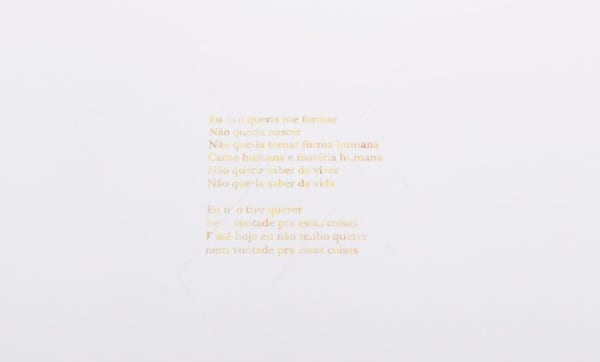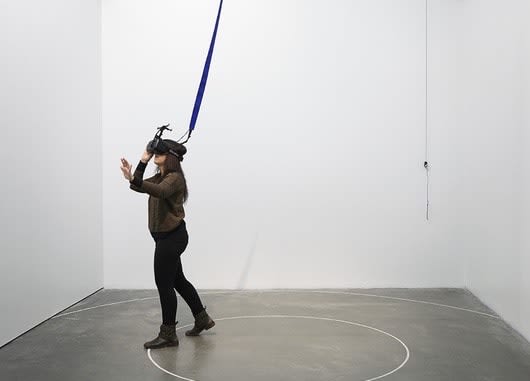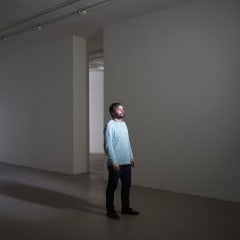Mendes Wood DM has the pleasure of presenting Reino de todos os animais e de todos os bichos é meu nome [Kingdom of all the animals and all the beasts is my name], the third solo exhibition at the gallery by Catalan artist Daniel Steegmann Mangrané. The set of works displayed features two pieces never before seen in Brazil alongside a new body of work on the walls.
Produced in 2013-2014 for the 2015 Triennial at the New Museum: Surround Audience, curated by Lauren Cornell, Phantom (kingdom of all the animals and all the beasts is my name) and Spiral Forest (kingdom of all the animals and all the beasts is my name) explored the same locale of tropical Brazilian forest through two divergent technologies. While Phantom uses one of the most advanced digital techniques, Spiral Forest was created with analogical and mechanical technologies, some of which are nearly obsolete.
To produce Phantom, Steegmann Mangrané worked with the London-based company ScanLab. Together, they scanned a piece of the forest, creating a point cloud of extremely high resolution. ScanLab then used an application called Unity to read the scan, making it accessible via a pair of virtual reality glasses. A set of optitrack cameras track the position of the spectator in the space, enabling the viewer move through the virtual forest.
To create Spiral Forest, the artist collaborated with engineers Nicola di Chio and Stefan Knauer, who constructed a Gimbal (a hinged device which allows an object to rotate on the same axis) activated by the motor of a 16 mm camera. By turning on the camera and starting to film, the gimbal rotates its three axes (pan, tilt, roll), conducting the filming process while executing interlinked movements. The sequence of movements was based on a mathematical calculation between angles of rotation and frames per second that guarantees all the possible combinations of movements and directions.
The differences between the two works are not limited to a mere digital – analogical binomial, but rather investigate two ways of apprehending opposites. While Phantom is set in a lit room, the image is fixed and the spectator moves throughout the real and virtual space; Spiral Forest is projected in a dark room, where the image is in motion and the body of the spectator is immobile.
The possibilities of phenomenological exploration of that which each technology offers are extremely important to the artist. While the body of the spectator is turned around and around in the continuous spiral of Spiral Forest, projecting into it and entering the flow of the image in motion (chiasmic entanglement, as Vivian Sobchack would say), this same body is disconnected and evaporated in the forest of Phantom. It confirms the psychasthenic urge to dissolve oneself in the world described by sociologist and literary critic Roger Callois [1].
The artist's emphasis on the use of such diverse technologies resides in the desire to explore the ways our knowledge of nature is mediated by them. Each new relevant form of technology has transformed our understanding of nature and our place in the universe. With each change in our conception of nature, we have been forced to adjust our understanding of our own nature.
Which changes force upon us the changes that we have provoked in the Earth and nature in the last few centuries?
Both works allow us to be situated in a new perspective, echoing the Amerindian cosmologies that have so strongly influenced the artist.
Randomly distributed on the gallery's walls are 5 poems by Stela do Patrocínio, as transcribed by Viviane Mosé in the book for which the exhibition was named [2].
Carla Guagliardi, a Brazilian artist who resides in Berlin, introduced Steegmann Mangrané to do Patrocinio's poems soon after they met. They have been a strong influence on the artist ever since then. Stela do Patrocínio lived in the Colônia Juliano Moreira mental hospital – the same institution in which visual artist Arthur Bispo do Rosário was hospitalized – where Guagliardi participated in a program of visiting artists. There she met Stela and recorded her daydreams/poems on numerous cassette tapes that were later transcribed in the book Reino dos animais e dos bichos é meu nome [Kingdom of all the animals and all the beasts is my name], which was a finalist for the 2002 Jabuti Prize.
The singularity of Stela do's voice, much like the violence/resistance to everything that the Ego tries to constitute, close, frame, hold, echoes in these works on the wall where the poems are fragmented by geometric designs resembling the ones in the collage Kiti Ka'aeté (2011) displayed at the exhibition's entrance.
Though on other occasions Steegmann Mangrané's geometric designs overlap with organic phenomena of great complexity like forest, here they are juxtaposed to Patrocinio's radical discourse. The work becomes a register of the contradictions and the ills of her mind and soul that is disjointed and fragmented like the text lacerated by the blindness of the straight line.
Surprisingly, Stela do Patrocínio's texts seem to echo the words of Merleau-Ponty: Where are we to put the limit between the body and the world, since the world is flesh? Where in the body are we to put the seer, since evidently there is in the body only shadows stuffed with organs, that is, more of the visible? The world seen is not in my body, and my body is not in the visible world ultimately: as flesh applied to a flesh, the world neither surrounds it nor is surrounded by it. A participation in and kinship with the visible, the vision neither envelops it nor is enveloped by it definitively. The superficial pellicle of the visible is only for my vision and for my body. But the depth beneath this surface contains my body and hence contains my vision. My body as a visible thing is contained within the full spectacle. But my seeing body subtends this visible body, and all the visibles with it. There is reciprocal insertion and and intertwining of one in the other [3].
[1] Mimicry and Legendary Psychasthenia, Roger Callois
[2] The title of the exhibition is not exactly the same as the title of Stela's book, but instead the verse itself and the way the artist often remembered it.
[3] The Interlacing – The Chiasm, Maurice Merleau-Ponty in The Visible and the Invisible
-
 Daniel Steegmann Mangrané, Kiti Ka’aeté, 2009
Daniel Steegmann Mangrané, Kiti Ka’aeté, 2009 -
 Daniel Steegmann Mangrané, É dito: pelo chão você não pode ficar, 2016
Daniel Steegmann Mangrané, É dito: pelo chão você não pode ficar, 2016 -
 Daniel Steegmann Mangrané, Eu não queria me formar, 2016
Daniel Steegmann Mangrané, Eu não queria me formar, 2016 -
 Daniel Steegmann Mangrané, Não sou eu que gosto de nascer, 2016
Daniel Steegmann Mangrané, Não sou eu que gosto de nascer, 2016 -
 Daniel Steegmann Mangrané, Eu era gases puro, ar, espaço vazio, tempo, 2016
Daniel Steegmann Mangrané, Eu era gases puro, ar, espaço vazio, tempo, 2016 -
 Daniel Steegmann Mangrané, Phantom (kingdom of all the animals and all the beasts is my name), 2014-2015
Daniel Steegmann Mangrané, Phantom (kingdom of all the animals and all the beasts is my name), 2014-2015 -
 Daniel Steegmann Mangrané, Spiral Forest (kingdom of all the animals and all the beasts is my name), 2014-2015
Daniel Steegmann Mangrané, Spiral Forest (kingdom of all the animals and all the beasts is my name), 2014-2015









